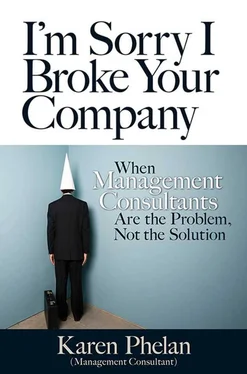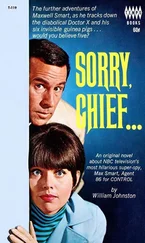Karen Phelan - I'm Sorry I broke Your Company
Здесь есть возможность читать онлайн «Karen Phelan - I'm Sorry I broke Your Company» весь текст электронной книги совершенно бесплатно (целиком полную версию без сокращений). В некоторых случаях можно слушать аудио, скачать через торрент в формате fb2 и присутствует краткое содержание. Город: San Francisco, Год выпуска: 2013, ISBN: 2013, Издательство: Berrett-Koehler Publishers, Жанр: management, popular_business, на английском языке. Описание произведения, (предисловие) а так же отзывы посетителей доступны на портале библиотеки ЛибКат.
- Название:I'm Sorry I broke Your Company
- Автор:
- Издательство:Berrett-Koehler Publishers
- Жанр:
- Год:2013
- Город:San Francisco
- ISBN:978-1-60994-740-8; 978-1-60994-741-5
- Рейтинг книги:3 / 5. Голосов: 1
-
Избранное:Добавить в избранное
- Отзывы:
-
Ваша оценка:
- 60
- 1
- 2
- 3
- 4
- 5
I'm Sorry I broke Your Company: краткое содержание, описание и аннотация
Предлагаем к чтению аннотацию, описание, краткое содержание или предисловие (зависит от того, что написал сам автор книги «I'm Sorry I broke Your Company»). Если вы не нашли необходимую информацию о книге — напишите в комментариях, мы постараемся отыскать её.
I'm Sorry I broke Your Company — читать онлайн бесплатно полную книгу (весь текст) целиком
Ниже представлен текст книги, разбитый по страницам. Система сохранения места последней прочитанной страницы, позволяет с удобством читать онлайн бесплатно книгу «I'm Sorry I broke Your Company», без необходимости каждый раз заново искать на чём Вы остановились. Поставьте закладку, и сможете в любой момент перейти на страницу, на которой закончили чтение.
Интервал:
Закладка:
The objects of science behave according to the laws of nature because they have no will. Cells divide, planets orbit suns, acids combined with bases explode, and temperature and pressure change the form of elements, all in predictable patterns. None of these objects have a consciousness, an ego, feelings, or a sense of humor. In contrast, the animal kingdom, of which we are part, is constantly surprising us. Who knew that penguins could be homosexual, that bacteria could «speak» complicated languages, or that pigeons could figure out mazes? Yet much of management science assumes that people are rational entities that will behave according to set rules. We know that individual humans do not behave on a purely rational basis, but still we assume that when we put lots of people together, somehow all their irrationalities cancel out each other, and these people behave according to rational formulas. (How many people are required to make the transition from an irrational to a rational body?)
Because management is not actually a science, there are no «answers» and, especially, no business «solutions.» Nevertheless, business management theory consists of numerous methodologies and prepackaged solutions that provide step-by-step instructions on how to be successful. It's ingrained in the thinking of the business world that following a best practice will guarantee success. Very few people even question this assumption. When data shows that most process reengineering efforts fall short of their expected benefits, most mergers and acquisitions fail, and companies with executive incentive compensation plans tend to underperform those without, instead of questioning the validity of the theory, executives try to figure out which step they did wrong so they can try it again. These methods and solutions are the fad diets and miracle foods of the business world. As long as business executives keep searching for magical solutions and guaranteed step-by-step plans, businesses will never develop a healthy approach to management. Business is not different from life; it is life. What you need to create a healthy business is the same as what you need to create a healthy life. Fads and step-by-step methods simply don’t work in either case.
A long time ago, I realized that it is much easier to work with human nature than against it. Even more importantly, you are much more likely to be successful when you work with humans rather than against them. The underpinning of Taylorism was to get humans to behave like machines, to act contrary to human nature. Managers often complain that the reason their initiative failed was because the employees lacked the discipline to follow it. Members of a species that created space flight, the Internet, cartoons, and music videos are not equipped to follow highly regimented processes or to be purely rational or to sacrifice their dignity for the sake of corporate policies. Rather than imposing these methods on our workforce in an effort to remove the human variability, executives need to use these methods as tools to take advantage of human variability. Instead of trying to take the humanity out of the workplace, we need to strive to develop as much humanity as possible. The difference is understanding that the solutions, methods, and theories are not the truth but someone’s perception of how the world works. We can learn from other people’s perceptions to broaden our own insight, but we need to recognize there is a good chance that some of their ideas are wrong.
That’s the trick, isn’t it? How can you discern the good ideas from the bad? It all starts with thinking. Well, it all starts with starting to think. Although I place a lot of the blame for our corporate malaise on consultants, companies are also at fault. Many companies hire consultants to do their thinking for them. Companies will routinely hire consultants to develop their strategies or restructure their companies or determine the feasibility of an acquisition with the result being that people who know nothing about your business are making the most important decisions about your business. One of the biggest flaws of Taylorism was trying to separate the thinking from the work. This legacy lives on in the business world, where thinking is often discouraged while task completion is rewarded. Given the choice of a software program or a checklist or a spreadsheet that spits out an answer versus an opinion from a human brain, many businesses will opt for the nonbrain choice.
Changing our thinking is at the same time the hardest and the easiest thing to do. To that end, I have put together some exercises to help you think without a consultant. The point of these exercises is to help you think about your business in a different context, outside the management-method-fads context and into a creating-a-healthy-business-lifestyle paradigm. Keep in mind that these are not solutions, just ways to help you identify what might be a myth.
Thinking exercise 1: Strive to enhance humanity
If the basic building blocks of businesses are people, then anything that helps people improve should improve your business. The way I see it, organizations consist of four elements — the individuals, subgroups and their interactions, the entire group, and the interactions of the entire group with the rest of the world. This is a guideline I use to determine if a new program or initiative is going to help or harm the organization. It doesn’t really matter what the initiative is called as long as it does one of the following:
1. Improve relationships. My biggest successes with process reengineering projects came when we improved relationships across different functional areas. Early initiatives in process reengineering and quality circles got people together to solve problems and share information. The biggest problem with talent management systems is that they replace relationships with paperwork and ratings. I have found that this is why some knowledge management efforts fail as well. They try to replace learning from someone else with a document. Whenever someone has extra budget money to spend on training, I usually recommend some kind of communications training. The more comfortable your organization is with open and honest conversations between all layers of the hierarchy, the more likely problems and issues will become visible quickly and resolved quickly. In my experience, many business problems are due to a lack of communication, and often my real value as a consultant is in being a communications vehicle between functions or levels. That's an expensive way to communicate.
If your program is going to improve relationships, you've got a winner. If it is an attempt to replace relationships, good luck with that!
2. Improve judgment or expand thinking. This could apply to anything that helps improve decision making and judgment, like better information, more insight, and clearer reports. Supply-chain automation delivered great benefits because all the suppliers and vendors could see the same information and make decisions based on it. Strategic planning is great at increasing knowledge. Metrics help, too. The problem is when you try to use these tools in place of judgment. A piece of paper or a complicated information system does not have the capacity for analysis, information gathering, synthesis, and conclusion that a human has. Automated call centers with push-button menus and standardized scripts are universally hated by customers because they try to replace human judgment. Databases with information on common problems and customer histories, however, help a customer service representative troubleshoot because they provide information to help judgment. There's a big difference between a checklist containing a list of questions to consider and one that calculates a rating at the bottom. People don’t mind adding more questions to the former; it just gives them more to think about. However, if you have to tabulate every line item for a score, everyone will want to keep that checklist short and simple, thus providing less information to consider while making a decision.
Читать дальшеИнтервал:
Закладка:
Похожие книги на «I'm Sorry I broke Your Company»
Представляем Вашему вниманию похожие книги на «I'm Sorry I broke Your Company» списком для выбора. Мы отобрали схожую по названию и смыслу литературу в надежде предоставить читателям больше вариантов отыскать новые, интересные, ещё непрочитанные произведения.
Обсуждение, отзывы о книге «I'm Sorry I broke Your Company» и просто собственные мнения читателей. Оставьте ваши комментарии, напишите, что Вы думаете о произведении, его смысле или главных героях. Укажите что конкретно понравилось, а что нет, и почему Вы так считаете.












